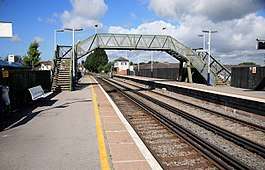Wool railway station
Wool railway station serves the village of Wool in Dorset, England. It is on the South Western Main Line, 125 miles 69 chains (202.6 km) down the line from London Waterloo.
| Wool | |
|---|---|
 | |
| Location | |
| Place | Wool |
| Local authority | Dorset Council |
| Coordinates | 50.682°N 2.221°W |
| Grid reference | SY845869 |
| Operations | |
| Station code | WOO |
| Managed by | South Western Railway |
| Number of platforms | 2 |
| DfT category | E |
| Live arrivals/departures, station information and onward connections from National Rail Enquiries | |
| Annual rail passenger usage* | |
| 2014/15 | |
| 2015/16 | |
| 2016/17 | |
| 2017/18 | |
| 2018/19 | |
| History | |
| Original company | Southampton and Dorchester Railway |
| Pre-grouping | London and South Western Railway |
| Post-grouping | Southern Railway |
| 1 June 1847 | Station opened |
| National Rail – UK railway stations | |
| |
History
When the Southampton and Dorchester Railway (S&DR) was opened on 1 June 1847, Wool was one of the original stations on the line.[1][2] The line was originally built with a single track but no telegraph, with the result that there was a head-on collision between Wool and Wareham on 27 September 1847; casualties were light.[3] The S&DR was amalgamated into the London and South Western Railway (LSWR) on 11 October 1848, and that company doubled the line in stages: the section from Wimborne to Wool was doubled on 1 June 1863, and the double track was extended from Wool to Dorchester on 1 August 1863.[4]
The station was host to a Southern Railway camping coach from 1936 to 1939.[5]
Two camping coaches were positioned here by the Southern Region from 1954 to 1960, the coaches were replaced in 1961 by two Pullman camping coaches until 1967.[6] The coaches were fitted with a full kitchen, two sleeping compartments and a room with two single beds.[7]
Services
Until 1967, trains through the station were normally steam hauled. Between 1967 and 1988, passenger services were normally provided by Class 33/1 diesel locomotives with Class 438 coaching stock (also known as 4-TC units). The line was electrified in 1988, using the standard British Rail Southern Region direct current third rail at 750 volts. Class 442 electric multiple units were initially used following electrification, until being displaced by new Class 444 electric multiple units in 2007.
There is a basic hourly service in each direction throughout the week, however peak times two trains an hour call in each direction on weekdays; these are operated by South Western Railway.[8]
| Preceding station | Following station | |||
|---|---|---|---|---|
| Wareham | South Western Railway South Western Main Line |
Moreton | ||
References
- Williams, R.A. (1968). The London & South Western Railway, volume 1: The Formative Years. Newton Abbot: David & Charles. p. 62. ISBN 0-7153-4188-X.CS1 maint: ref=harv (link)
- Butt, R.V.J. (1995). The Directory of Railway Stations. Yeovil: Patrick Stephens Ltd. p. 255. ISBN 1-85260-508-1. R508.CS1 maint: ref=harv (link)
- Williams 1968, pp. 63–64
- Williams 1968, p. 65
- McRae, Andrew (1997). British Railway Camping Coach Holidays: The 1930s & British Railways (London Midland Region). Scenes from the Past: 30 (Part One). Foxline. p. 33. ISBN 1-870119-48-7.
- McRae, Andrew (1998). British Railways Camping Coach Holidays: A Tour of Britain in the 1950s and 1960s. Scenes from the Past: 30 (Part Two). Foxline. pp. 57 & 59. ISBN 1-870119-53-3.
- "Pullman Cars as Camping Coaches". Railway Magazine. 107 (711): 449–450. July 1960.
- Table 158 National Rail timetable, May 2016
| Wikimedia Commons has media related to Wool railway station. |